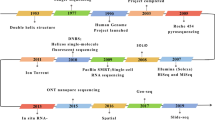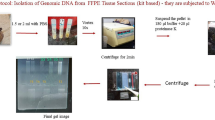Abstract
Background
Ribosomal DNA (rDNA) is the most abundant and important housekeeping gene in the cell. It usually acted as DNA damage sensor in DNA damage reaction. Gastric cancer (GC) as a tumor with high morbidity and mortality, it is hard to diagnosis in an early stage.
Methods
In this study, we collected and test the copy number of rDNA in blood sample of 42 GC patients and 56 healthy controls (HC) to explore the relationship between rDNA and GC. Besides, we make a correlation between the copy number of rDNA and ten biomarkers (CYFR21-1, CA15-3, CA72-4, NSE, CEA, CA125, ProGRP, AFP, SCC, CA19-9).
Results
The copy number of 18 S, 5.8 S, 28 S rDNA in GC is less than HC and 5 S is more than HC in their blood sample. And the expression of H-cox-1 and ND1 in GC is higher than HC in blood sample. it shows the expression of CA15-3 is related to ND1 and H-cox-1.
Conclusion
We found for the first time the changes of rDNA and mtDNA expression in the blood of patients with gastric cancer. All these finding suggests rDNA may have potential in diagnosing GC.


Similar content being viewed by others
Data availability
The data supporting the findings of this study are available from the corresponding author upon reasonable request.
References
Smyth EC, Nilsson M, Grabsch HI et al (2020) Gastric cancer. The Lancet 396:635–648. https://doi.org/10.1016/S0140-6736(20)31288-5
Thrift AP, El-Serag HB (2020) Burden of gastric cancer. Clin Gastroenterol Hepatol 18:534–542. https://doi.org/10.1016/j.cgh.2019.07.045
Goral V, Goral V (2016) Etiopathogenesis of gastric cancer. Asian Pac J Cancer Prev 17:2745–2750
Strong VE (2018) Progress in gastric cancer. Updates Surg 70:157–159. https://doi.org/10.1007/s13304-018-0543-3
Karimi P, Islami F, Anandasabapathy S et al (2014) Gastric cancer: descriptive epidemiology, risk factors, screening, and prevention. Cancer Epidemiol Biomark Prev 23:700–713. https://doi.org/10.1158/1055-9965.EPI-13-1057
Shimada H, Noie T, Ohashi M et al (2014) Clinical significance of serum tumor markers for gastric cancer: a systematic review of literature by the task force of the japanese gastric cancer association. Gastric Cancer 17:26–33. https://doi.org/10.1007/s10120-013-0259-5
Wang F-H, Shen L, Li J et al (2019) The chinese society of clinical oncology (CSCO): clinical guidelines for the diagnosis and treatment of gastric cancer. Cancer Commun 39:10. https://doi.org/10.1186/s40880-019-0349-9
Shin VY (2014) MiRNA as potential biomarkers and therapeutic targets for gastric cancer. WJG 20:10432. https://doi.org/10.3748/wjg.v20.i30.10432
Fang X, Wen J, Sun M et al (2019) CircRNAs and its relationship with gastric cancer. J Cancer 10:6105–6113. https://doi.org/10.7150/jca.32927
Gu Y, Chen T, Li G et al (2015) LncRNAs: emerging biomarkers in gastric cancer. Future Oncol 11:2427–2441. https://doi.org/10.2217/fon.15.175
Chen C, Du Y, Liu Y et al (2022) Characteristics of gastric cancer gut microbiome according to tumor stage and age segmentation. Appl Microbiol Biotechnol 106:6671–6687. https://doi.org/10.1007/s00253-022-12156-x
Chen C, Shen J, Du Y et al (2022) Characteristics of gut microbiota in patients with gastric cancer by surgery, chemotherapy and lymph node metastasis. Clin Transl Oncol 24:2181–2190. https://doi.org/10.1007/s12094-022-02875-y
Smirnov E, Chmúrčiaková N, Liška F et al (2021) Variability of human rDNA. Cells 10:196. https://doi.org/10.3390/cells10020196
Nelson JO, Watase GJ, Warsinger-Pepe N, Yamashita YM (2019) Mechanisms of rDNA copy number maintenance. Trends Genet 35:734–742. https://doi.org/10.1016/j.tig.2019.07.006
Hall AN, Morton E, Queitsch C (2022) First discovered, long out of sight, finally visible: ribosomal DNA. Trends Genet 38:587–597. https://doi.org/10.1016/j.tig.2022.02.005
Smirnov E, Chmúrčiaková N, Cmarko D (2021) Human rDNA and cancer. Cells 10:3452. https://doi.org/10.3390/cells10123452
Warmerdam DO, Wolthuis RMF (2019) Keeping ribosomal DNA intact: a repeating challenge. Chromosom Res 27:57–72. https://doi.org/10.1007/s10577-018-9594-z
Wang M, Lemos B (2017) Ribosomal DNA copy number amplification and loss in human cancers is linked to tumor genetic context, nucleolus activity, and proliferation. PLoS Genet 13:e1006994. https://doi.org/10.1371/journal.pgen.1006994
Valori V, Tus K, Laukaitis C et al (2020) Human rDNA copy number is unstable in metastatic breast cancers. Epigenetics 15:85–106. https://doi.org/10.1080/15592294.2019.1649930
Hosgood HD, Hu W, Rothman N et al (2019) Variation in ribosomal DNA copy number is associated with lung cancer risk in a prospective cohort study. Carcinogenesis 40:975–978. https://doi.org/10.1093/carcin/bgz052
Gershoni M, Templeton AR, Mishmar D (2009) Mitochondrial bioenergetics as a major motive force of speciation. BioEssays 31:642–650. https://doi.org/10.1002/bies.200800139
Taylor RW, Turnbull DM (2005) Mitochondrial DNA mutations in human disease. Nat Rev Genet 6:389–402. https://doi.org/10.1038/nrg1606
Pannunzio A, Coluccia M (2018) Cyclooxygenase-1 (COX-1) and COX-1 inhibitors in cancer: a review of oncology and medicinal chemistry literature. Pharmaceuticals 11:101. https://doi.org/10.3390/ph11040101
Sharma L, Lu J, Bai Y (2009) Mitochondrial respiratory complex I: structure, function and implication in human diseases. CMC 16:1266–1277. https://doi.org/10.2174/092986709787846578
Feng L (2020) Ribosomal DNA copy number is associated with P53 status and levels of heavy metals in gastrectomy specimens from gastric cancer patients. Environ Int 138:105593
Wang M, Lemos, B (2017) Genetic context and proliferation determine contrasting patterns of copy number amplification and loss for 5S and 45S ribosomal DNA arrays in cancer. Biorxiv. https://doi.org/10.1101/154120
Weeks SE, Metge BJ, Samant RS (2019) The nucleolus: a central response hub for the stressors that drive cancer progression. Cell Mol Life Sci 76:4511–4524. https://doi.org/10.1007/s00018-019-03231-0
Hung W-Y, Wu C-W, Yin P-H et al (2010) Somatic mutations in mitochondrial genome and their potential roles in the progression of human gastric cancer. Biochimica et Biophysica Acta 1800(3):264–270
Mahmoud EH, Fawzy A, Ahmad OK, Ali AM (2016) Plasma circulating cell-free nuclear and mitochondrial DNA as potential biomarkers in the Peripheral blood of breast cancer patients. Asian Pac J Cancer Prev 16:8299–8305. https://doi.org/10.7314/APJCP.2015.16.18.8299
Acknowledgements
We thank all participants in Zhejiang Provincial People’s Hospital for their help with this research.
Funding
This study was supported by the Zhejiang Provincial Program for Xinmiao Talents (2022R424B009).
Author information
Authors and Affiliations
Contributions
LJL designed and supervised this study; CCC and LFF drafted the manuscript; JFC provided technical and material support and data analysis; CCC and JS provided the samples and clinical data.
Corresponding author
Ethics declarations
Conflict of interest
The authors declare that they have no conflict of interest.
Ethical approval
All procedures performed in studies involving human participants were in accordance with the ethical standards of the national research committee, and this study was approved by the Ethics Committee of Zhejiang Provincial People’s Hospital (No. 2022QT010). All samples were anonymous.
Informed consent
All participants involved in this study, including patients, were fully informed about the study and voluntarily provided written informed consent before participating.
Additional information
Publisher’s Note
Springer Nature remains neutral with regard to jurisdictional claims in published maps and institutional affiliations.
Rights and permissions
Springer Nature or its licensor (e.g. a society or other partner) holds exclusive rights to this article under a publishing agreement with the author(s) or other rightsholder(s); author self-archiving of the accepted manuscript version of this article is solely governed by the terms of such publishing agreement and applicable law.
About this article
Cite this article
Chen, C., Feng, L., Chen, J. et al. Ribosomal DNA copy number alteration in blood sample from gastric cancer patients. Mol Biol Rep 50, 7155–7160 (2023). https://doi.org/10.1007/s11033-023-08630-y
Received:
Accepted:
Published:
Issue Date:
DOI: https://doi.org/10.1007/s11033-023-08630-y




